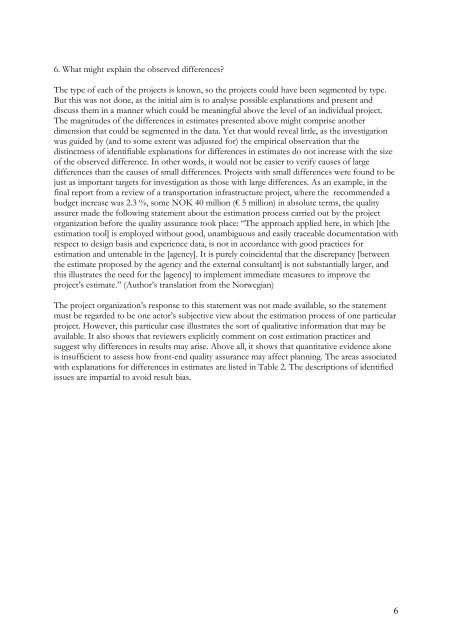Link to thesis. - Concept - NTNU
Link to thesis. - Concept - NTNU
Link to thesis. - Concept - NTNU
- No tags were found...
Create successful ePaper yourself
Turn your PDF publications into a flip-book with our unique Google optimized e-Paper software.
6. What might explain the observed differences?The type of each of the projects is known, so the projects could have been segmented by type.But this was not done, as the initial aim is <strong>to</strong> analyse possible explanations and present anddiscuss them in a manner which could be meaningful above the level of an individual project.The magnitudes of the differences in estimates presented above might comprise anotherdimension that could be segmented in the data. Yet that would reveal little, as the investigationwas guided by (and <strong>to</strong> some extent was adjusted for) the empirical observation that thedistinctness of identifiable explanations for differences in estimates do not increase with the sizeof the observed difference. In other words, it would not be easier <strong>to</strong> verify causes of largedifferences than the causes of small differences. Projects with small differences were found <strong>to</strong> bejust as important targets for investigation as those with large differences. As an example, in thefinal report from a review of a transportation infrastructure project, where the recommended abudget increase was 2.3 %, some NOK 40 million (€ 5 million) in absolute terms, the qualityassurer made the following statement about the estimation process carried out by the projec<strong>to</strong>rganization before the quality assurance <strong>to</strong>ok place: “The approach applied here, in which [theestimation <strong>to</strong>ol] is employed without good, unambiguous and easily traceable documentation withrespect <strong>to</strong> design basis and experience data, is not in accordance with good practices forestimation and untenable in the [agency]. It is purely coincidental that the discrepancy [betweenthe estimate proposed by the agency and the external consultant] is not substantially larger, andthis illustrates the need for the [agency] <strong>to</strong> implement immediate measures <strong>to</strong> improve theproject’s estimate.” (Author’s translation from the Norwegian)The project organization’s response <strong>to</strong> this statement was not made available, so the statementmust be regarded <strong>to</strong> be one ac<strong>to</strong>r’s subjective view about the estimation process of one particularproject. However, this particular case illustrates the sort of qualitative information that may beavailable. It also shows that reviewers explicitly comment on cost estimation practices andsuggest why differences in results may arise. Above all, it shows that quantitative evidence aloneis insufficient <strong>to</strong> assess how front-end quality assurance may affect planning. The areas associatedwith explanations for differences in estimates are listed in Table 2. The descriptions of identifiedissues are impartial <strong>to</strong> avoid result bias.6
















